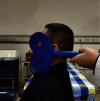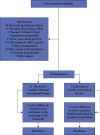Peripheral Repetitive Transcranial Magnetic Stimulation(rTMS) for Idiopathic Facial Nerve Palsy: A Prospective, Randomized Controlled Trial
- PMID: 35875789
- PMCID: PMC9300274
- DOI: 10.1155/2022/7536783
Peripheral Repetitive Transcranial Magnetic Stimulation(rTMS) for Idiopathic Facial Nerve Palsy: A Prospective, Randomized Controlled Trial
Abstract
Purpose: The purpose of this study was to evaluate the clinical efficacy of peripheral repetitive transcranial magnetic stimulation (rTMS) in the treatment of idiopathic facial paralysis, to explore an ideal treatment scheme for idiopathic facial paralysis, and to provide evidence for clinical rehabilitation.
Methods: 65 patients with idiopathic facial nerve palsy with the first onset were recruited and randomly divided into rTMS group and control group. Both groups received conventional treatment, rTMS group received additional repetitive transcranial magnetic stimulation to the affected side once a day, 5 times a week for 2 weeks. House-Brackmann (HB) grading scale, Sunnybrook facial grading system (SFGS), and modified Portmann scale (MPS) were used to assess facial nerve function before and after treatment, and the time for patients to return to normal facial nerve function and adverse reaction (AR) was also the main observation index.
Results: After a 2-week intervention, HB, SFGS, and MPS increased in both groups (P < 0.01); the improvement of HB, SFGS, and MPS in rTMS group was significantly higher than that in control group (P < 0.01). The effective improvement rate of the TMS group after 2 weeks was 90.0%, and that of the control group was 53.3%, and the difference was statistically significant (P < 0.01).
Conclusions: Repetitive transcranial magnetic stimulation is a safe and effective noninvasive method for the treatment of idiopathic facial paralysis, which can significantly accelerate the recovery of facial nerve function and provide a new treatment idea for further improving the prognosis of patients with idiopathic facial paralysis.
Copyright © 2022 Zicai Liu et al.
Conflict of interest statement
All authors declare that there is no conflict of interest in publishing this article.
Figures




References
-
- Goo B., Jeong S. M., Kim J. U., et al. Clinical efficacy and safety of thread-embedding acupuncture for treatment of the sequelae of Bell’s palsy: a protocol for a patient-assessor blinded, randomized, controlled, parallel clinical trial. Medicine (Baltimore) . 2019;98(7, article e14508) doi: 10.1097/md.0000000000014508. - DOI - PMC - PubMed
Publication types
MeSH terms
LinkOut - more resources
Full Text Sources
Medical
Research Materials

